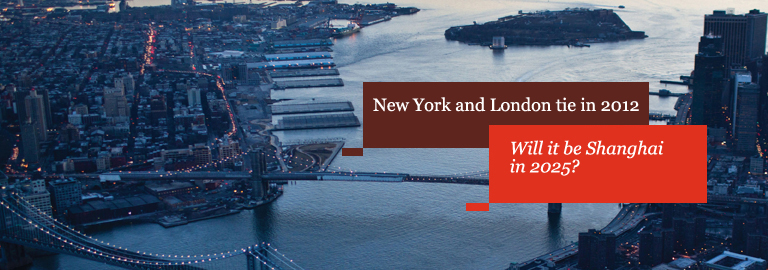How leading global cities stack up against one another? Though New York and London lead cumulative scoring, emerging cities, including Beijing and Shanghai, are narrowing the gap within key economic indicators, according to the fifth edition of Cities of Opportunity released by PwC and the Partnership for New York City.
While New York officially edges out London by one point across 10 economic indicators, the city wins in no individual category. Toronto, which finishes third, also shows great balance yet wins no category. London, however, takes the lead in “city gateway,” an indicator introduced this year that measures global interconnectedness and international attraction. Rounding out the leaders are Paris, which advances four spots from 2011 to number four, and Stockholm at number five.
In addition to looking at the current performance of 27 cities that are global capitals of finance, commerce and culture, the study for the first time analyzes city employment in the most significant and telling job sectors and projects the trajectory of the cities in jobs, economic output, and population to 2025.
The Cities of Opportunity key indicators and top three cities within are:
Intellectual capital and innovation: Stockholm, Toronto, Paris
Technology readiness: Seoul, San Francisco, New York
Transportation and Infrastructure: Singapore, Seoul/Toronto (tied for second), Tokyo
Health, safety and security: Stockholm, Toronto, Sydney
Sustainability and the natural environment: Sydney, San Francisco/Toronto (tied for second), Berlin
Economic clout: Beijing, Paris, London/New York (tied for third)
Ease of doing business: Singapore, Hong Kong, New York
Cost: Berlin, Seoul, Kuala Lumpur
Demographics and livability: Paris, Hong Kong/Sydney (tied for second), San Francisco
City gateway: London, Paris, Beijing.
Beijing advanced to the top spot in “economic clout” while Shanghai placed fifth behind Paris, London, and New York. This is the first time two emerging cities appeared in the top five of this indicator category.
Beijing and Shanghai are also in the top five in a new category, “city gateway,” along with London, Paris, and New York. Balanced progress across a range of social and economic indicators represents the next step for these cities in transforming exceptional growth into sustainable performance for these emerging cities.
For the first time, the 2012 report provides an in-depth look at some of the most significant and telling job sectors, now and looking ahead to 2025. The financial and business services, manufacturing, and wholesale and retail sectors anchor many city economies in 2012. Financial and business services when grouped together account for more than a third of the jobs in Milan, Paris, London, Beijing, San Francisco and Stockholm. One in three Shanghai jobs today is in manufacturing, although the study projects the city shifting to a more diversified economy by 2025.
Wholesale and retail make up more than 20 percent of the workforce in Hong Kong, Kuala Lumpur, Moscow, Mumbai, Mexico City and Istanbul. New York leads the world in healthcare employment with nearly 16 percent of its workforce in the field, while Abu Dhabi takes the lead in hospitality and tourism.


